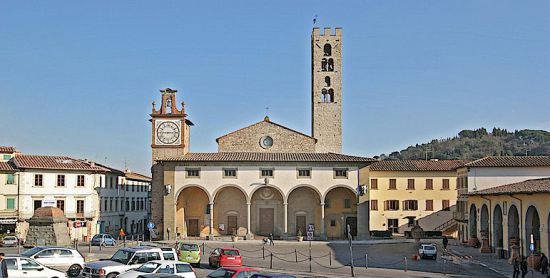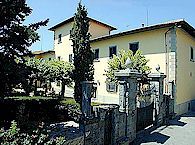Impruneta - an introduction
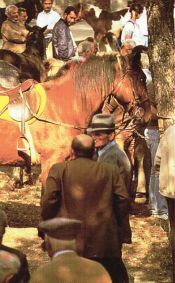 Impruneta is a Tuscan hill town located between the valleys of the Greve and the Ema streams, about half an hour south of Florence. It was known in ancient times as "in prunetis" or "in pineta" (within the pine woods) and indeed remnants of beautiful pine forests may still be seen interspersed among the olive groves on some of the surrounding hills. During the mediaeval period, Impruneta and the surrounding villages were part of the fiefdom of the Buondelmonti family whose castle was in the village of Montebuoni. The family first appears in history in the 10 C in the person of Sichelmo and they were finally driven from their castle in 1135 by the Florentines. The family retreated to Florence where the Buondelmonti and the Fifani families played a significant role in exacerbating the division of the Florentine population between the Guelf and Ghibelline factions. Their responsibility arose most notably from an infamous drunken fight and subsequent macchinations regarding whose daughter would marry whom, leading up to the murder of Buondelmonti di Buondelmonti, on his wedding day during Easter 1216, by Oddo Arrighi of Fifanti. Years of factional bloodshed are said to have begun with this event.
Impruneta is a Tuscan hill town located between the valleys of the Greve and the Ema streams, about half an hour south of Florence. It was known in ancient times as "in prunetis" or "in pineta" (within the pine woods) and indeed remnants of beautiful pine forests may still be seen interspersed among the olive groves on some of the surrounding hills. During the mediaeval period, Impruneta and the surrounding villages were part of the fiefdom of the Buondelmonti family whose castle was in the village of Montebuoni. The family first appears in history in the 10 C in the person of Sichelmo and they were finally driven from their castle in 1135 by the Florentines. The family retreated to Florence where the Buondelmonti and the Fifani families played a significant role in exacerbating the division of the Florentine population between the Guelf and Ghibelline factions. Their responsibility arose most notably from an infamous drunken fight and subsequent macchinations regarding whose daughter would marry whom, leading up to the murder of Buondelmonti di Buondelmonti, on his wedding day during Easter 1216, by Oddo Arrighi of Fifanti. Years of factional bloodshed are said to have begun with this event.The Church of Santa Maria at Impruneta became ever more well-known for the sacred and miraculous effigy of the Madonna housed there. Pilgrims came in large numbers and a famous fair took place and still takes place on the feast of Saint Luke, 18 October. Originally a feast associated with the movement and sale of livestock, it is now celebrated with stalls, dinners and horse races.
A small village important for the production of pottery had developed near the church. The first record of terracotta manufacture dates from 1098 and the production of terracotta tiles, pottery and bricks has continued to flourish to the present time. The church and its treasure, and the pottery kilns and their output are the principal reasons to visit Impruneta.
However, there are many other interesting sights in Impruneta and nearby, and throughout the year there are festivals and cultural activities that make the short journey from Florence worthwhile. And if you are interested in castles, Chianti is full of them and they are described in the itineraries of the Chianti Castles route.
Things to see in and near Impruneta
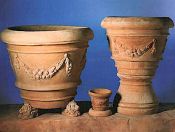 The terracotta workshops
The terracotta workshopsThese outlets all manufacture their own products from the local clay, some of it excavated on their own properties. Production ranges from small, mould-made plaques and small to life-sized statues, through hand-made decorative pots of all sizes to gigantic garden vases and oil jars. A large range of floor and roof tiles is also made. Most of the production has the natural red finish, some of it patinated by exposure to the sun and rain. More about Impruneta Terracotta.
Beautiful hand-painted plates and jars are also produced in Impruneta. More about hand-painted ceramics.
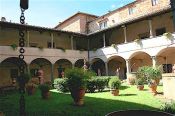 The Basilica of Santa Maria and its Treasure Museum
The Basilica of Santa Maria and its Treasure MuseumThe church dates back to the XI century, but it has been rebuilt on several occasions. A splendid 13C bell-tower. Inside there are valuable paintings and sculptures on display. 15C altar-steps, a 14C polyptych. A 14C cloister. The museum houses a collection of material of historical and artistic importance of various centuries: sacred ornaments made of gold, furnishings, hangings, votive vases, sculptures made of silver and a precious series of crosses, one of which is attributed to Ghiberti.
 Public Library
Public LibraryImpruneta boasts a fine, modern public library located on Piazza Buondelmonti across the square from the Church of Impruneta. Local newspapers are available as well as numerous reference and guide books, mainly in Italian. Also a nice place just to sit down and watch the activity in the piazza.
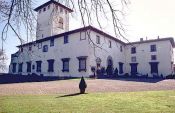 Villa Corsini at Mezzomonte
Villa Corsini at Mezzomonte This villa is a superb example of a Tuscan country palace. The villa was at one time the centre of a farm surrounded by olive groves and vineyards, eight kilometers south of Florence, between Grassina and Impruneta. Villa Corsini enjoys a marvellous location in one of the few untouched valleys in the surroundings of Florence. It's importance, other than the beauty of the gardens, the grounds and the rooms, resides in the frescoes with which it is decorated. They were painted during the 17 C and are the work of some of the greatest masters of the period, Giovanni di San Giovanni, Michele Colonna, Pandolfo Sacchi, Domenico Cresti detto Il Passignano. More about Villa Corsini.
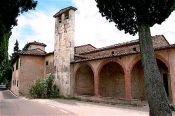 Church of Saint Miniato in Quintole
Church of Saint Miniato in QuintoleVia di Quintole per Le Rose
This XIV century church is typical for its use of terracotta as an architectural and decorative element, as in the external trimmings of the arches and of the pillars in the portico and the terracotta lunette above the door. The church has an architectural style which is both elegant and, at the same time, severe. Its plan is a Latin Cross and its portico has three wide arcades. Inside, in one of the chapels, there are Mediaeval and Renaissance remains including a Virgin with Child and other fragments from frescoes of the Florentine school at the beginning of the 14 C. In the apse, there is a Virgin with four saints, a wooden board painted by Bicci di Lorenzo at the beginning of the 15 C.
 Church of San Lorenzo alle Rose
Church of San Lorenzo alle RoseThis church has very ancient origins. The documentation goes back to the 11 C and it was rebuilt in the 14 C. The church was under the patronage of the Rossi and then the Grifoni, wealthy families of the city who possessed large estates in this area. The interior plan is rectangular and was contructed in the 16 C. Over the centuries, the building underwent many transformations. The side altars were raised and a stone altar substituted for the wooden one. The facade is preceded by an arcade with Tuscan columns. Behind the main altar, there is an Annunciation attributed to the Maestro da Serumido, the conventional name of an eccentric artist who was active in Florence in the 16 C. On the right side-altar, there is San Nicola da Bari by Andrea Boscoli (1596) and on the left a painting attributed to Francesco Curradi depicting Saints Domenico and Caterina. At one time, the central space housed the Virgin with Child by Taddeo Gaddi. This painting, usually attributed to the late period of Giotto’s most faithful disciple, is now in the presbytery.
There are several villas which are worth looking at from the outside. These include Villa Il Prato, which is today the seat of Opera Pia L. Vanni, the 17 C Villa Carrega in Via Roma, today a private house, and Villa Citernesi in Via di Candegli. There are also a number of fine villas in the territory of Impruneta, among them Villa Corsini at Mezzamonte, which belonged to Lorenzo de'Medici and is extremely beautiful - both the villa itself and the gardens. There are many more 16 C villas spread along the Via Imprunetana in the direction of Pozzolatico on the route to and from Florence, as well as La Capella Rossa in Quintole and La Torre Rossa in San Gersolè. On the Via Imprunetana towards Tavarnuzze there are the 15 C Villa La Querce, the Istituto Suore Domenicane in a 16 C villa, and Villa Accursio. Some of these are on good hiking routes. There is also good bicycling to be had in this area.
Tavarnuzze is one of the most interesting of the nearby towns. The main sites are the Church of Saint Peter (Chiesa di San Pietro) at Montebuoni, the Chapel of the Buondelmontis (Cappella dei Buondelmonti) and the Hospital of St. Julian (lo Spedale di San Giuliano). They are all related in one way or another to the Buondelmonti family which originated in or near Tavarnuzze before expanding to Impruneta and finally Florence.
Tavarnuzze is one of the most interesting of the nearby towns. The main sites are the Church of Saint Peter (Chiesa di San Pietro) at Montebuoni, the Chapel of the Buondelmontis (Cappella dei Buondelmonti) and the Hospital of St. Julian (lo Spedale di San Giuliano). They are all related in one way or another to the Buondelmonti family which originated in or near Tavarnuzze before expanding to Impruneta and finally Florence.

